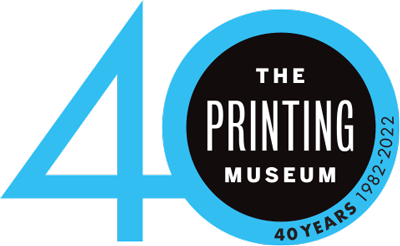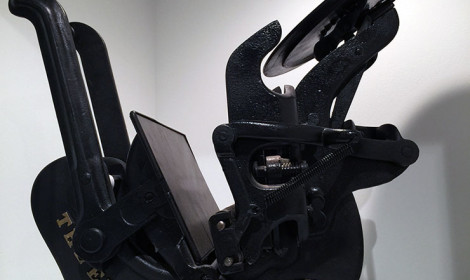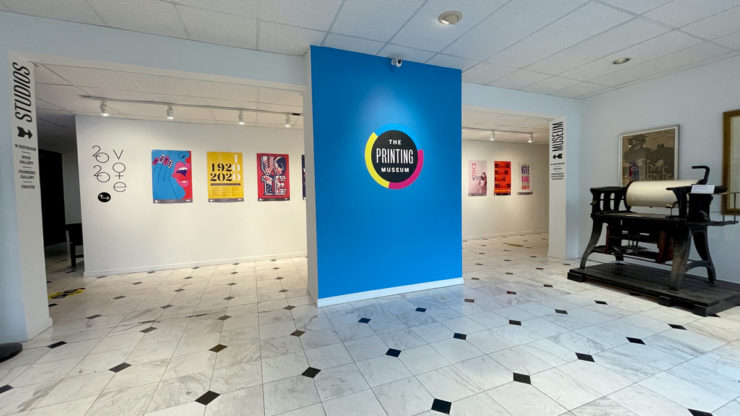
The selection of objects on display in The Printing Museum’s collections demonstrate how printing has significantly contributed to the development of civilization-transforming our lives to the present day. The galleries unfold in a broad chronology and illustrate the enduring impact of printing by exploring the intersections of the history, art, and technology. Seminal moments from the past—from the invention of paper and moveable type to the struggle of free press in the early American Republic to important advances in printing technology and publishing in the twentieth-century—highlight how technological and artistic advances often fueled significant historical events throughout the centuries.
Discover how themes related to printing—such as access to information, censorship, education, and literacy—are recurrent throughout past centuries, and resonate with similar advances, issues, and concerns that are prevalent in our contemporary digital society. Printing has been, and continues to be, a means for significant social, political and cultural change.
Early Communication Gallery
This first gallery explores the development of writing, books and paper in some of the earliest civilizations, including the Mesopotamia, Egypt, Mesoamerica, and East Asia. As nomadic cultures began to settle and form cities, governments and societies—a need emerge to record properly and mark goods, as well as to facilitate transactions and communications.
Systems of writing were established from pictograms (painted or imprinted images that represent things) to ideograms (written symbols that represent concepts), and some to alphabetic systems (symbols corresponding to sounds). Coinciding with the development of written language that was the development of tools and materials to record these communications, including the invention of papyrus in Egypt around 3000 B.C.E., paper in China in 105 C.E. as well as the refinement of parchment (a treated animal skin) in Pergamon (present day Turkey) around 300 B.C.E.
In most of these early civilizations, writing and literacy was reserved for a small elite class and written documents were for administrative and/or religious purposes. Subsequently, early forms of writing and printing often conveyed mystical and symbolic power to masses of illiterate populations-and the process of writing, transcribing, and copying became a ritualistic practice for scribes. Even as Asian, Middle Eastern, Greco-Roman and other Latin cultures established systems of education and libraries (both secular and religious)-poetry, calligraphy, illustration and book production remained the domain of an educated elite.
Highlights Include:
- Mesopotamian Cylinder Seals (c. 3000-1000 BCE)
- Ancient Papyrus Fragments (c. 300-350 BCE)
- Moveable Type from Korea
- The Hyakumanto Dharani (765-770 A.D.) of Japan
- Early Asian Printing (c. 8th & 19th Centuries CE)
- Illuminated Manuscripts (c. 13th-16th Centuries CE)
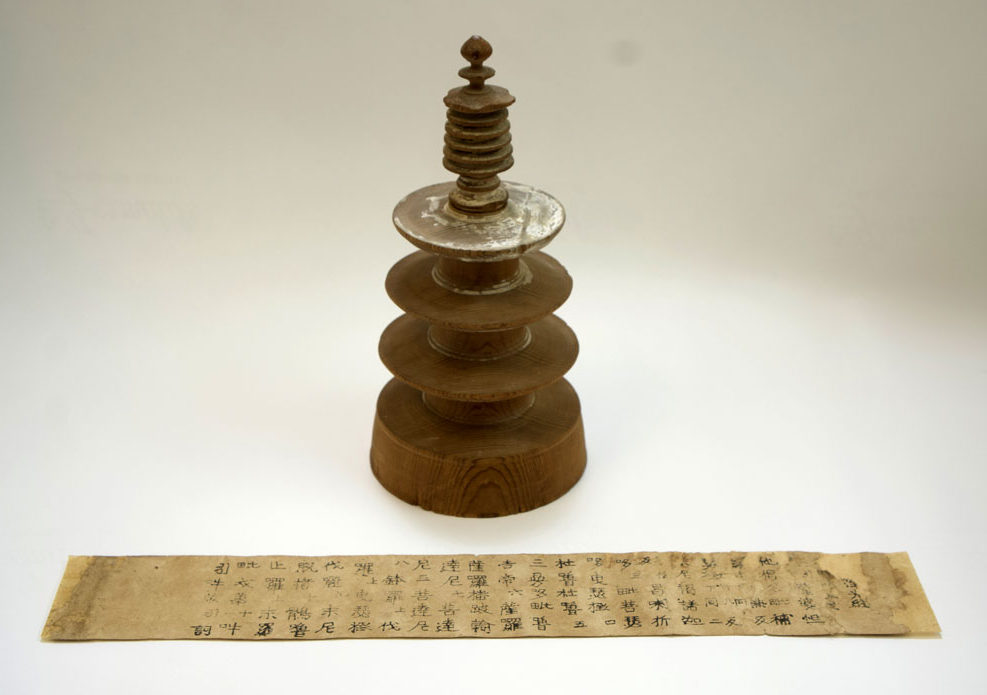
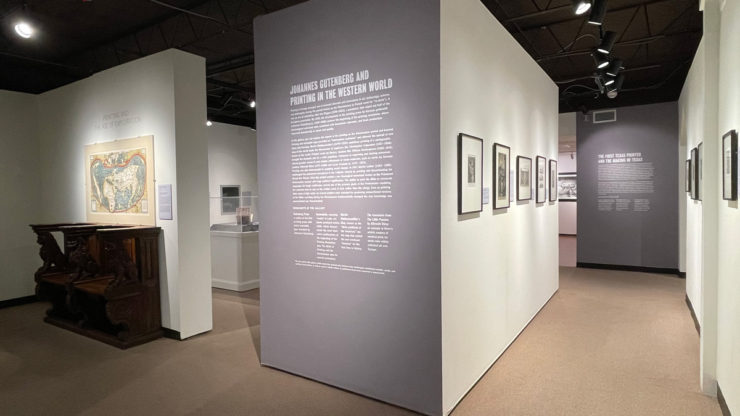
Johannes Gutenberg Gallery
Printing in Europe emerged out of the renewed interest and innovations in art, technology, science, and philosophy during the period known as the Renaissance (a French word for “re-birth). It was an era of rebuilding after the Plague (1346-1353), a pandemic that wiped out half of the European population. By 1450, the development of the printing press by German goldsmith Johannes Gutenberg (c. 1400-1468) marked the beginning of the printing revolution, where technological advances were combined with humanistic interests, and book production improved dramatically in speed and quality.
In this gallery, you can explore printing’s impact on the Renaissance period and beyond. Printing and moveable type provided an “information explosion” and allowed the spread of new ideas and learning. Martin Waldseemüller’s (1470-1520) ambitious printing of a cartographic map of the world, significant for presenting the Americas as its own continent, made the discoveries of explorers like Christopher Columbus (1451-1506) known to the world. Printed works by literary masters like William Shakespeare (1582-1616) brought the dramatic arts to a wider populace. Advances in engraving and etching processes offered greater access to and artistic refinement of visual materials, such as works by German printers Albrech Dürer (1471-1528) and Lucas Cranach (c. 1472-1553).
Printing was also instrumental in enabling social change. In 1517, Martin Luther (1483-1586) challenged the perceived corruptions in the Catholic Church by printing and disseminating his Ninety-five Theses. From this printed protest a new theological movement know as the Protestant Reformation ensued with huge political significance. The ability to print the Bible in vernacular languages or larger audience, served one of the primary goals of the Protestants-enabling the common man to rely on the written word of God, rather that the clergy. Even as printing often came at high costs-as several printers were executed for producing unsanctioned versions of the Bible-printing during the Renaissance fundamentally changed the way knowledge was accumulated and disseminated.
- Working historically accurate replica of Gutenberg’s press and a Fine Art Facsimile of The Gutenburg Bible
- Leaves from Luther’s Bible (1597), Tyndale Bible (1535), Coverdale Bible (1535), King James Bible (1611), and others
- 15th- and 16th-Century Old Master Engravings from the Bader Collection, including The Ascension from The Little Passion by Albrecht Dürer
- Waldseemüller map (facsimile)
- Shakespeare’s Second Folio
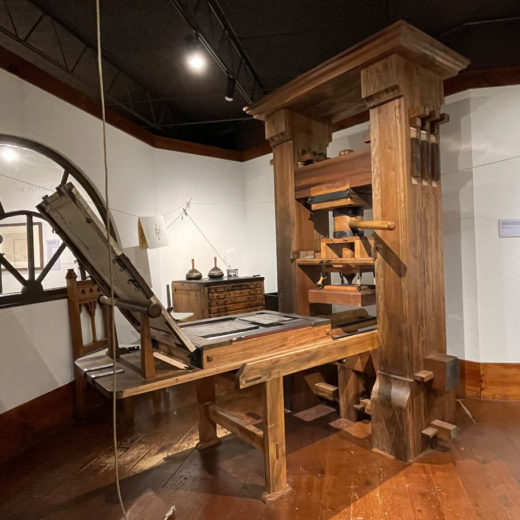
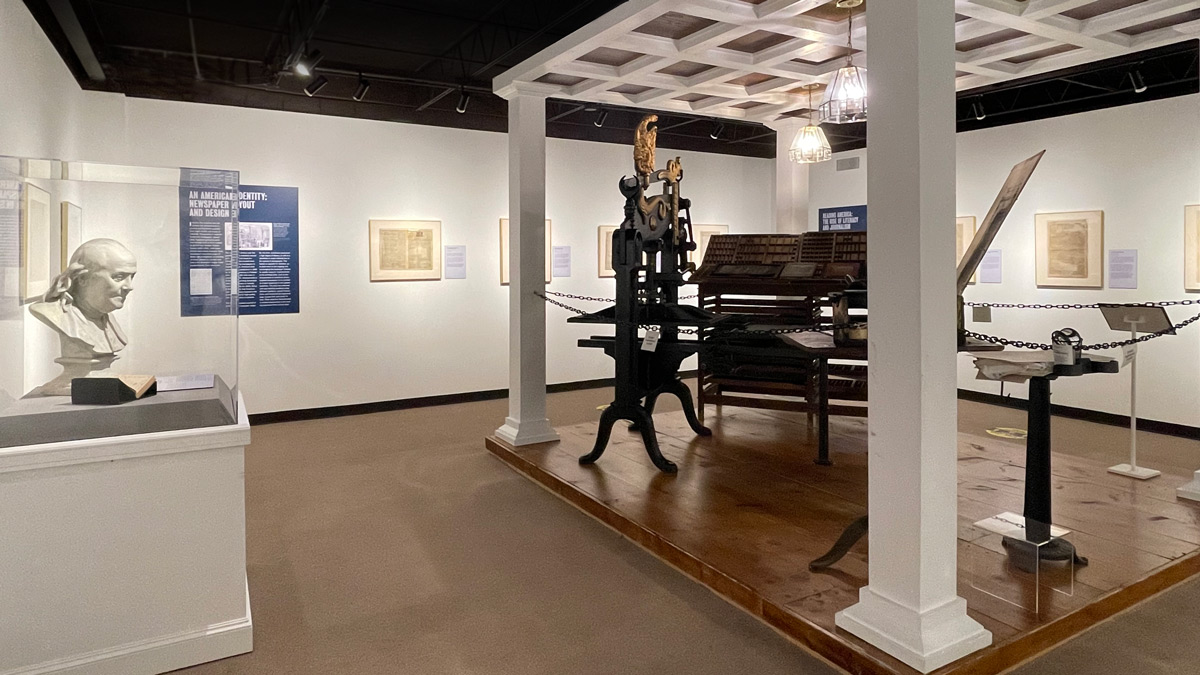
Early Newspapers and the Founding of a Nation
The story of printing in the United State is woven into the founding of the nation. After the first printing press arrived in the New World in 1638, printers like Benjamin Franklin (1706-1790), Isaiah Thomas (1749-1831), and John Peter Zenger (1697-1746) pioneered ways to deliver news, knowledge, and political views to their readers. Newspapers became important channels for colonists and American citizens to express ideological beliefs, to discuss the future of the country, and to defend principles of liberty and freedom. With the help of technological and industrial innovations, printers became key figures in building a flourishing democratic republic and nascent “American” identity.
In this gallery, you can follow newspapers from the colonial period to the late-nineteenth century—tracing seminal moments and events in history, including the establishment of freedom of the press (1733), the setback and victories of American Revolution (1765-1783) from both sides, the battles and debates of the Civil War (1861-1865), and the emancipation of slaves fueled by Abraham Lincoln’s famous speech (1862). These documents and objects represent the printers’ perseverance and ingenuity in overcoming obstacles and in perusing freedom of thought and press. As you follow the printers’ visions and the voices conveyed throughout these newspapers, think about how our own modern—day society contents with the technological changes and journalistic challenges—and be reminded of how printing continues to be a tool for fighting suppression and censorship, as well as a tool for preserving our alienable rights and freedoms.
- Working 150-year old Columbian iron handpress.
- Original Pennsylvania Gazette published by Benjamin Franklin in 1765.
- Original New York Herald announcing the Emancipation Proclamation in 1863.
- original Thomas Nast cartoons from Harper’s Weekly that mark the first appearances in print of the Republican elephant, the Democratic donkey, Santa Claus and Uncle Sam.
- Frank Leslie’s Illustrated Newspaper
- The Revolution (1868), the official publication of the National Woman Suffrage Association
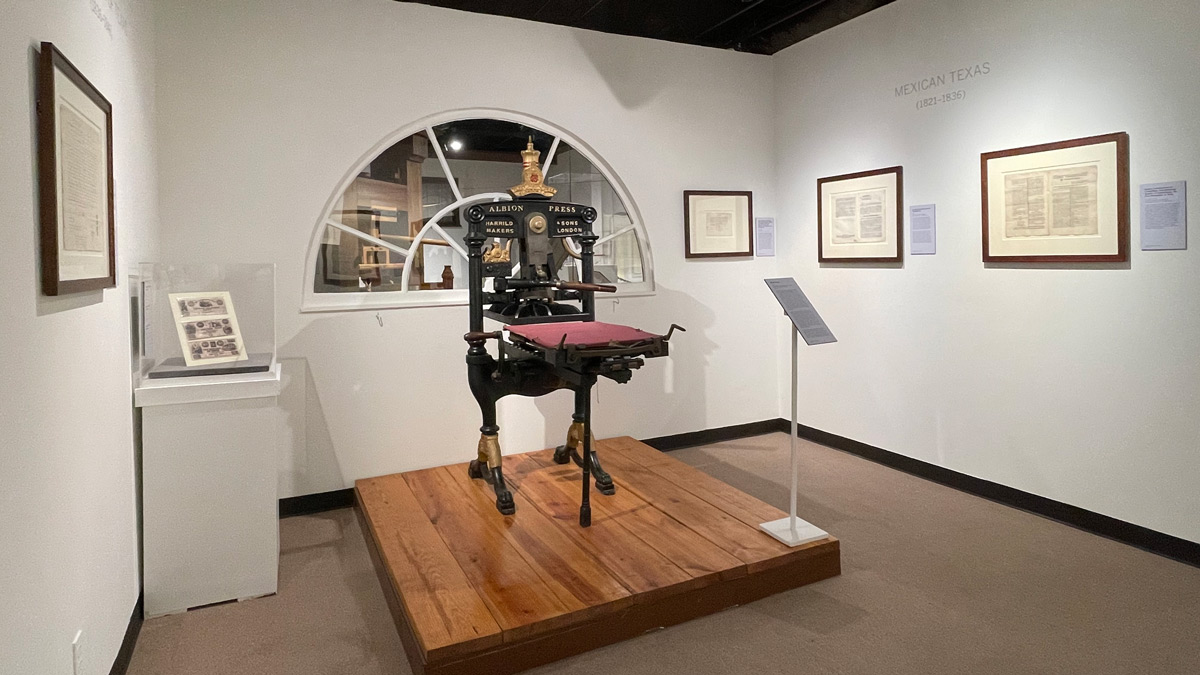
The First Texas Printer and the Making of Texas
This gallery features documents and artifacts related to the complicated history of the settlement of the land that is now the state of Texas. Printing and printed documents represent practical tools of a government’s authority to create laws, issue currency, and enforce titles of land ownership. The items in this gallery date from approximately 1820-1840. During this time Texas would transition through a series of wars and various forms of government: going from Spanish colonial rule until the Mexican Revolution in 1821; followed by Mexican governance and the eventual dictatorial rulership under General Antonio López de Santa Anna (1791-1876); and finally becoming an independent Republic after the Texas Revolution in 1836. Life on the frontier and the tumultuous political climate created opportunities, as well as numerous challenges, for a pioneer printer.
Samuel Bangs (ca. 1798-1854) was the first printer in Texas, west of the Mississippi, and three Mexican states. Trained in New England, he contributed greatly to the cultivation of a printing culture in the region. Documents printer under his oversight tell some on the story of this turbulent slice of history. Bangs faced seemingly unending adversity over the years, from a 7-year imprisonment to being cheated, and yet produced technically impressive and lasting work. Several fine examples of his printed specimens are presented in this gallery.
- Albion Press from circa 1829
- Ley de Colonización [Law of Colonization] 1828 document printed by Samuel Bangs for the Mexican government permitting Anglo-Saxons to settle land in Texas
- The Republic of Texas Indenture considered the “Rosetta Stone” for identifying printed works by Bangs with at least 18 different type designs
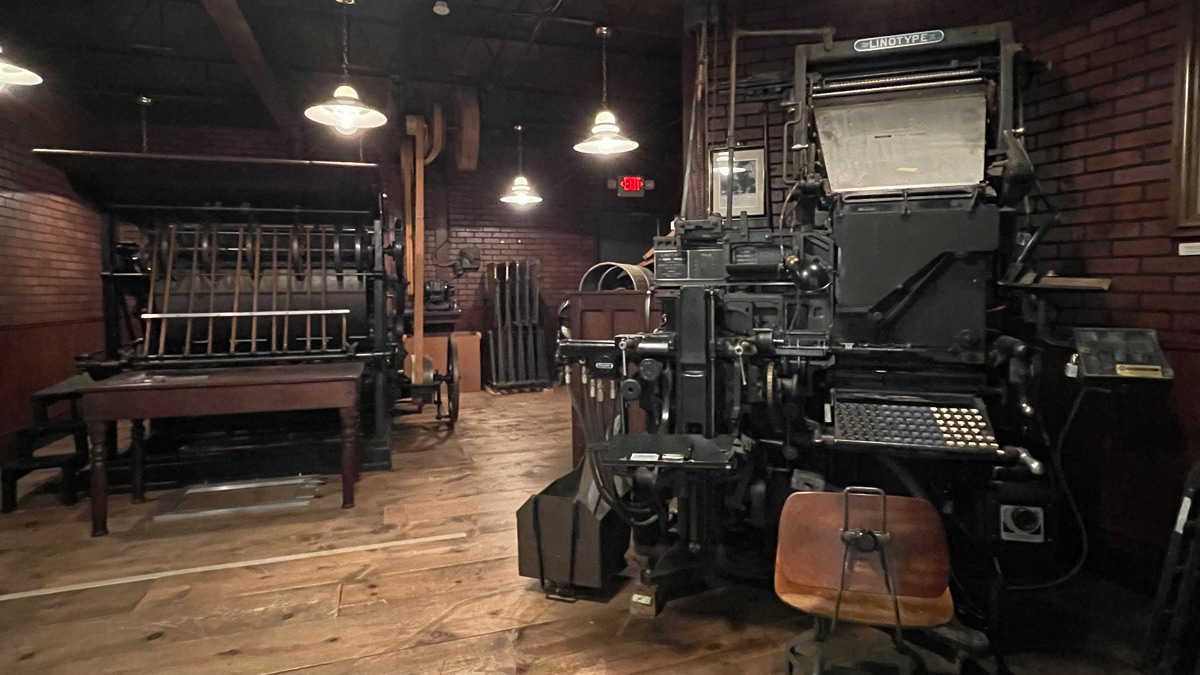
Hearst Newspaper Gallery
This gallery displays early newspaper equipment, including a 20th century model Linotype machine, invented by Ottmar Merganthaler in 1886. Dubbed by Thomas Edison as “the eighth wonder of the world,” the Linotype drastically changed the speed of production of newspapers and books, and is credited with a sharp increase in literacy rates in the early 1900s.
- Working Model 31 Linotype machine
- Cranston Newspaper Press
- Stereotype Shaver, c. 1867
On the Front Page Gallery
Installation in progress
This hall of historic headlines, dating from the 1610s to 2009, mark important historical events, such as the sinking of the Titanic, the 1929 Stock Market Crash, the 1969 Moon Landing, and the election of President Barack Obama.
Modern Technology Gallery
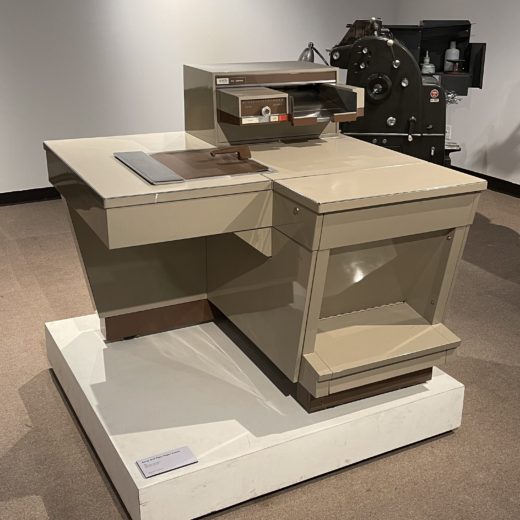
Much like the innovations in the 21st Century information technology, printing in the 20th century was an arena for creative minds. Printing inventions represented in this gallery exemplify its lasting and widespread impact upon the way people communicated through writing, printing and copying.
Modern innovators built upon the foundations of their predecessors. Offset printing based upon the 18th-century lithographic process is still widely used. The perseverance of inventive minds such as Chester Carlson and his XEROX machine completely transformed the way we think of printed pages.
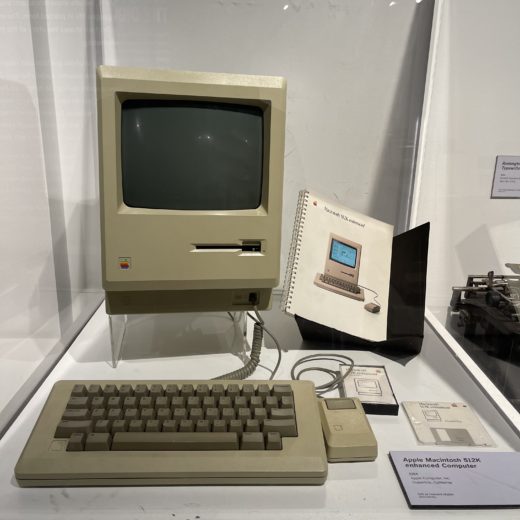
Changing technology pushed and pulled people in different directions. The smaller, faster, and more reliable machines such as typewriters and computers drew people into the world of personal publishing and content creation, moving people in and out of the modern workforce, and bringing them together as a community.
- Xerox 914 Plain Paper Copier
- Harris Offset Printing Press, one of the first commercially sold offset presses.
- IBM Correcting Selectric II typewriter
The Printing Museum Theater
The museum theater provides an opportunity to view documentary and feature films about and related to printing, including Harvest of Wisdom, a 45-minute video on the history of human communication and the important role of printing.
